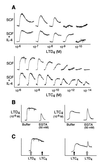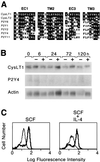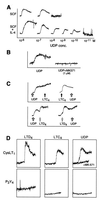Cysteinyl leukotriene receptor 1 is also a pyrimidinergic receptor and is expressed by human mast cells - PubMed (original) (raw)
Cysteinyl leukotriene receptor 1 is also a pyrimidinergic receptor and is expressed by human mast cells
E A Mellor et al. Proc Natl Acad Sci U S A. 2001.
Abstract
The cysteinyl leukotrienes (cys-LTs) LTC(4), LTD(4), and LTE(4) are a class of peptide-conjugated lipids formed from arachidonic acid and released during activation of mast cells (MCs). We now report that human cord-blood-derived MCs (hMCs) express the CysLT1 receptor, which responds not only to inflammation-derived cys-LTs, but also to a pyrimidinergic ligand, UDP. hMCs express both CysLT1 protein and transcript, and respond to LTC(4), LTD(4), and UDP with concentration-dependent calcium fluxes, each of which is blocked by a competitive CysLT1 receptor antagonist, MK571. Stably transfected Chinese hamster ovary cells expressing the CysLT1 receptor also exhibit MK571-sensitive calcium flux to all three agonists. Both hMCs and CysLT1 transfectants stimulated with UDP are desensitized to LTC(4), but only partially to LTD(4). Priming of hMCs with IL-4 for 5 days enhances their sensitivity to each agonist, but preferentially lowers their threshold for activation by LTC(4) and UDP (approximately 3 log(10)-fold shifts in dose-response for each agonist) over LTD(4) (1.3 log(10)-fold shift), without altering CysLT1 receptor mRNA or surface protein expression, implying the likely induction of a second receptor with CysLT1-like dual ligand specificity. hMCs thus express the CysLT1 receptor, and possibly a closely related IL-4-inducible receptor, which mediate dual activation responses to cys-LTs and UDP, providing an apparent intersection linking the inflammatory and neurogenic elements of bronchial asthma.
Figures
Figure 1
Calcium responses of hMCs to stimulation with LTD4 and LTC4, and preferential up-regulation by IL-4 of the response to LTC4. (A) hMCs maintained in SCF alone (100 ng/ml) or primed for 5 days with IL-4 (10 ng/ml) in the continued presence of SCF exhibit dose-dependent calcium responses to LTD4 (Upper) or LTC4 (Lower). The depicted results reflect separate experiments for LTD4 and LTC4 performed with hMCs from different donors. Priming the hMCs with IL-4 shifted the 50% maximal response to LTD4 (1.33 ± 0.41 log-fold increment, mean ± SEM, n = 3), and to LTC4 (mean, 3.83 ± 1.94 log-fold increment, n = 3) in every experiment performed. (B) The sustained phase of the cys-LT-induced calcium signal to each agonist was abolished by EGTA. (C) At 1 μM concentrations, LTD4 completely desensitized the hMCs to LTC4, whereas LTC4 partly desensitized them to LTD4. The depicted results for IL-4-primed hMCs were replicated three times for A and C, and two and three times for B.
Figure 2
Effect of pharmacologic receptor inhibitors on cys-LT-mediated calcium signals of IL-4-primed hMCs. (A) The competitive CysLT1 receptor antagonist MK571 (1 μM) completely blocked the responses of IL-4-primed hMCs to 1 μM LTD4 (Upper) and LTC4 (Lower). (B) BAY-u9773 (5 μM), which blocks the CysLT1 receptor but activates and desensitizes the CysLT2 receptor, yielded a small calcium signal in IL-4-primed hMCs that did not attenuate the subsequent calcium response to LTD4 (Upper), but partly blocked the agonist effect of LTC4 (Lower). The data depicted in A and B were replicated in two additional experiments, each with hMCs of different donors.
Figure 3
Expression of the CysLT1 and P2Y4 receptors by hMC. (A) Homology domains in the amino acid sequences of the CysLT1 receptor, the CysLT2 receptor, and the known existing human P2Y receptors, in the first (EC1) and third (EC3) extracellular loops, and second (TM2) and third (TM3) transmembrane domains. Shaded residues indicate identity to the CysLT1 receptor. (B) RNA blot analysis detecting transcripts encoding the cys-LT and P24 receptors in RNA extracted from 107 hMCs maintained over a 5-day period in the presence of SCF alone (−) or with IL-4 (10 ng/ml) (+). Hybridization signals reflecting steady-state levels of mRNA encoding the CysLT1 and P2Y4 receptors are displayed, whereas the CysLT2 and P2Y6 receptors were not detected and are not shown. (C) Membrane expression of the CysLT1 receptor is not altered by 5 days of priming with IL-4. Bold tracings indicate staining with an anti-CysLT1 polyclonal antibody, while lighter tracings depict staining with a rabbit IgG of irrelevant specificity. The depicted cytofluorographs are representative of two experiments performed.
Figure 4
LTC4 and UDP share receptors on hMC. (A) Effect of IL-4 priming of hMCs for 5 days compared with maintenance in SCF alone on dose-dependent calcium flux in response to UDP (10−11 M to 10−6 M). (B) The calcium signal induced by UDP (1 μM) is completely inhibited by MK571 (1 μM). (C) Cross-desensitization between UDP and LTC4 was complete at 1 μM of each agonist. In contrast, UDP did not desensitize the hMCs to LTD4, although LTD4 did desensitize the cells to UDP. (D) Stably transfected CHO cells expressing the human P2Y4 receptor do not respond to cys-LTs or UDP. CHO cells expressing the long isoform of the mouse CysLT1 receptor respond to LTD4 (10−9 M), LTC4 (10−7 M), and UDP (10−6 M, tracings shown with and without the addition of an equimolar concentration of MK571). The depicted results were replicated two times each for A, B, and C, with hMCs from different donors, and three times for D.
Similar articles
- Expression of the type 2 receptor for cysteinyl leukotrienes (CysLT2R) by human mast cells: Functional distinction from CysLT1R.
Mellor EA, Frank N, Soler D, Hodge MR, Lora JM, Austen KF, Boyce JA. Mellor EA, et al. Proc Natl Acad Sci U S A. 2003 Sep 30;100(20):11589-93. doi: 10.1073/pnas.2034927100. Epub 2003 Sep 17. Proc Natl Acad Sci U S A. 2003. PMID: 13679572 Free PMC article. - Expression of functional cysteinyl leukotriene receptors by human basophils.
Gauvreau GM, Plitt JR, Baatjes A, MacGlashan DW. Gauvreau GM, et al. J Allergy Clin Immunol. 2005 Jul;116(1):80-7. doi: 10.1016/j.jaci.2005.03.014. J Allergy Clin Immunol. 2005. PMID: 15990778 - Functional characterisation of receptors for cysteinyl leukotrienes in smooth muscle.
Jonsson EW. Jonsson EW. Acta Physiol Scand Suppl. 1998 Mar;641:1-55. Acta Physiol Scand Suppl. 1998. PMID: 9597121 Review. - A review on leukotrienes and their receptors with reference to asthma.
Singh RK, Tandon R, Dastidar SG, Ray A. Singh RK, et al. J Asthma. 2013 Nov;50(9):922-31. doi: 10.3109/02770903.2013.823447. Epub 2013 Aug 16. J Asthma. 2013. PMID: 23859232 Review.
Cited by
- Trichinella spiralis secreted enzymes regulate nucleotide-induced mast cell activation and release of mouse mast cell protease 1.
Afferson HC, Eleftheriou E, Selkirk ME, Gounaris K. Afferson HC, et al. Infect Immun. 2012 Nov;80(11):3761-7. doi: 10.1128/IAI.00411-12. Epub 2012 Aug 13. Infect Immun. 2012. PMID: 22890994 Free PMC article. - Pharmacological evidence for a novel cysteinyl-leukotriene receptor subtype in human pulmonary artery smooth muscle.
Walch L, Norel X, Bäck M, Gascard JP, Dahlén SE, Brink C. Walch L, et al. Br J Pharmacol. 2002 Dec;137(8):1339-45. doi: 10.1038/sj.bjp.0704991. Br J Pharmacol. 2002. PMID: 12466244 Free PMC article. - P2Y6 receptors require an intact cysteinyl leukotriene synthetic and signaling system to induce survival and activation of mast cells.
Jiang Y, Borrelli L, Bacskai BJ, Kanaoka Y, Boyce JA. Jiang Y, et al. J Immunol. 2009 Jan 15;182(2):1129-37. doi: 10.4049/jimmunol.182.2.1129. J Immunol. 2009. PMID: 19124756 Free PMC article. - Leukotriene B4, an activation product of mast cells, is a chemoattractant for their progenitors.
Weller CL, Collington SJ, Brown JK, Miller HR, Al-Kashi A, Clark P, Jose PJ, Hartnell A, Williams TJ. Weller CL, et al. J Exp Med. 2005 Jun 20;201(12):1961-71. doi: 10.1084/jem.20042407. Epub 2005 Jun 13. J Exp Med. 2005. PMID: 15955837 Free PMC article. - Concentration-dependent noncysteinyl leukotriene type 1 receptor-mediated inhibitory activity of leukotriene receptor antagonists.
Woszczek G, Chen LY, Alsaaty S, Nagineni S, Shelhamer JH. Woszczek G, et al. J Immunol. 2010 Feb 15;184(4):2219-25. doi: 10.4049/jimmunol.0900071. Epub 2010 Jan 18. J Immunol. 2010. PMID: 20083671 Free PMC article.
References
- Chervinsky P, Brandon M, Zhang J, Kundu S, McBurney J, Reiss T F. Eur Resp J. 1998;11:1232–1239. - PubMed
- Suissa S, Dennis R, Ernst P, Sheehy O, Wood-Dauphinee S. Ann Intern Med. 1997;126:177–183. - PubMed
- Dixon R A, Diehl R E, Opas E, Rands E, Vickers P J, Evans J F, Gillard J W, Miller D K. Nature (London) 1990;343:282–284. - PubMed
- Reid G K, Kargman S, Vickers P J, Mancini J A, Leveille C, Ethier D, Miller D K, Gillard J W, Dixon R A, Evans J F. J Biol Chem. 1990;265:19818–19823. - PubMed
Publication types
MeSH terms
Substances
Grants and funding
- P01 HL036110/HL/NHLBI NIH HHS/United States
- U19 AI031599/AI/NIAID NIH HHS/United States
- AI-22531/AI/NIAID NIH HHS/United States
- AI-01305/AI/NIAID NIH HHS/United States
- HL-36110/HL/NHLBI NIH HHS/United States
- P01 AI031599/AI/NIAID NIH HHS/United States
- AI-31599/AI/NIAID NIH HHS/United States
LinkOut - more resources
Full Text Sources
Molecular Biology Databases



